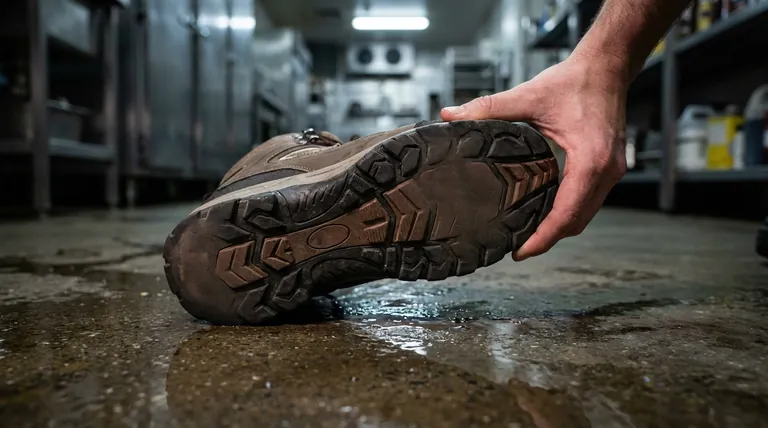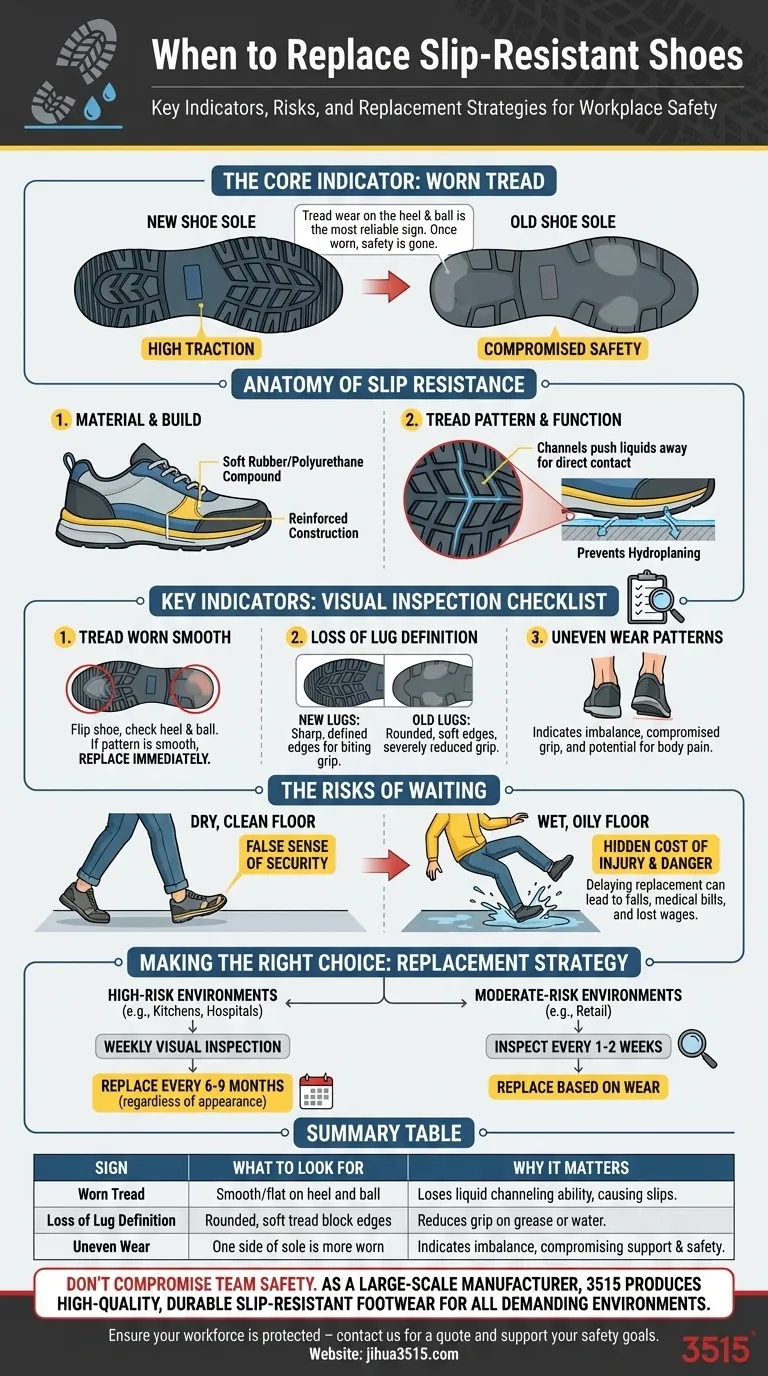The most reliable indicators that your slip-resistant shoes need replacing are found by examining the sole. When the texture of the tread pattern begins to look smooth or flattened, especially around the heel and the ball of the foot, the shoe's ability to provide traction is significantly compromised.
Your shoe's slip resistance is not a feature of the entire shoe; it is almost entirely dependent on the integrity of the tread pattern on its sole. Once that specific pattern wears down, the shoe has lost its primary safety function, even if the rest of it looks fine.

The Anatomy of Slip Resistance
To understand when a shoe is failing, you must first understand how it works. Slip-resistant shoes are not just regular footwear with a different label; they are purpose-built tools for safety.
More Than Just a Rubber Sole
The foundation of a non-slip shoe is its material and construction. The soles are typically made from a softer rubber or polyurethane compound designed to grip surfaces more effectively.
Unlike everyday sneakers, they often feature reinforced materials and a sturdier build to endure the demanding conditions of professional environments.
The Critical Role of Tread Patterns
The true workhorse of a slip-resistant shoe is its intricate tread pattern. These small, complex channels and grooves are engineered to do one thing: push liquids out from under the shoe.
This channeling action allows the sole to make direct, firm contact with the floor surface, dramatically increasing traction and preventing the hydroplaning effect that causes slips on wet or greasy floors.
Key Indicators Your Shoes Need Replacing
Relying on a specific timeframe, like six months or a year, is unreliable. Your work environment, hours on your feet, and even your gait determine a shoe's lifespan. Instead, perform a regular visual inspection, focusing on these critical failure points.
1. The Tread Is Worn Smooth
This is the most obvious and urgent sign. Flip your shoes over and look at the areas that receive the most pressure: the ball of the foot and the heel.
If the detailed pattern in these areas has worn away and become smooth to the touch, the shoe can no longer channel away liquids effectively. Its primary safety feature is gone.
2. Loss of Lug Definition
The individual blocks or shapes that make up the tread pattern are called lugs. When the shoe is new, these lugs have sharp, defined edges that provide biting grip.
Over time, these edges become rounded and soft. Once the lugs lose their definition, their ability to cut through surface contaminants and grip the floor is severely reduced.
3. Uneven Wear Patterns
Pay close attention to how the sole is wearing down. If one side of the heel is significantly more worn than the other, it indicates an imbalance.
This not only compromises the shoe's grip but can also lead to a lack of support, potentially causing foot, leg, and back pain over long shifts.
Understanding the Trade-offs: The Risk of Waiting
It can be tempting to push your footwear a little longer to save money, but with safety equipment, this creates a dangerous situation.
A False Sense of Security
A worn-out slip-resistant shoe may still feel perfectly fine on a dry, clean floor. This creates a false sense of security.
The shoe's true test is on the exact surface it was designed for—a wet, oily, or otherwise contaminated floor. A worn shoe will fail precisely when you need it most, with no warning.
The Hidden Cost of Injury
The cost of a new pair of quality work shoes is minimal compared to the potential cost of a fall.
Medical bills, lost wages from time off work, and long-term pain are the real expenses you risk by delaying replacement. Investing in proper footwear is an investment in your own well-being.
Making the Right Choice for Your Goal
Your replacement strategy should be based on the level of risk in your daily environment.
- If your primary focus is safety in high-risk environments (e.g., commercial kitchens, hospitals, industrial settings): Perform a weekly visual inspection of your shoe's tread and plan to replace them on a regular schedule (e.g., every 6-9 months) regardless of appearance.
- If your primary focus is stability in moderate-risk environments (e.g., retail, servers on mostly dry floors): A thorough visual inspection every one to two weeks is your most reliable guide for determining when a replacement is necessary.
Prioritizing the condition of your shoe's sole is a direct investment in your personal safety on the job.
Summary Table:
| Sign | What to Look For | Why It Matters |
|---|---|---|
| Worn Tread | Tread pattern is smooth/flat on heel and ball of foot. | Loses ability to channel liquids, causing slips. |
| Loss of Lug Definition | Sharp edges of tread blocks become rounded and soft. | Reduces grip on contaminated surfaces like grease or water. |
| Uneven Wear | One side of the sole is more worn than the other. | Indicates imbalance, compromising support and safety. |
Don't let worn-out soles compromise your team's safety. As a large-scale manufacturer, 3515 produces a comprehensive range of high-quality, durable slip-resistant footwear for distributors, brand owners, and bulk clients. Our production capabilities encompass all types of safety shoes and boots designed for demanding environments. Ensure your workforce is protected with reliable footwear—contact us today for a quote and discover how we can support your safety goals.
Visual Guide

Related Products
- Safety Footwear Wholesale Manufacturer for Custom OEM/ODM Production
- Advanced KPU Athletic Safety Shoe with Steel Toe Cap Anti-Slip Rotary Lacing System
- Premium Suede Sport Safety Shoes for Wholesale & Bulk Orders
- Wholesale Premium Waterproof Nubuck Safety Shoes Boots
- Wholesale Customizable Safety Boots Durable & Protective Footwear Manufacturing
People Also Ask
- What cultural and environmental considerations are tied to wearing shoes indoors? Balance Hygiene, Tradition, and Foot Health
- What do heavy duty boots do? Protect Your Feet in Demanding Work Environments
- Is safety-toe as good as steel toe? Choose the Right Protection for Your Job
- How do safety shoes contribute to cost savings for companies? A Strategic Investment in Risk and Cost Management
- What are OSHA approved shoes? Understanding the Correct Standards for Workplace Safety



















